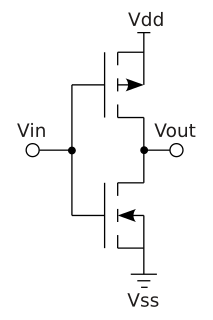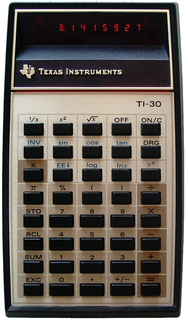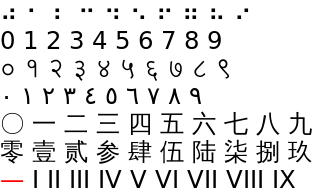
An electronic calculator is typically a portable electronic device used to perform calculations, ranging from basic arithmetic to complex mathematics.
Scientific notation is a way of expressing numbers that are too big or too small to be conveniently written in decimal form. It is commonly used by scientists, mathematicians and engineers, in part because it can simplify certain arithmetic operations. On scientific calculators it is usually known as "SCI" display mode.
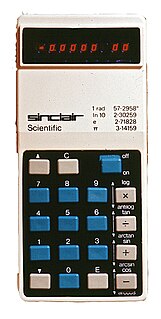
The Sinclair Scientific calculator was a 12-function, pocket-sized scientific calculator introduced in 1974, dramatically undercutting in price other calculators available at the time. The Sinclair Scientific Programmable, released a year later, was advertised as the first budget programmable calculator.

The HP-35 was Hewlett-Packard's first pocket calculator and the world's first scientific pocket calculator: a calculator with trigonometric and exponential functions.
IBM System/360 computers, and subsequent machines based on that architecture (mainframes), support a hexadecimal floating-point format (HFP).
TI-BASIC is the official name of a BASIC-like language built into Texas Instruments (TI)'s graphing calculators. TI-BASIC is a language family of three different and incompatible versions, released on different products:
Engineering notation or engineering form is a version of scientific notation in which the exponent of ten must be divisible by three (i.e., they are powers of a thousand, but written as, for example, 106 instead of 10002). As an alternative to writing powers of 10, SI prefixes can be used, which also usually provide steps of a factor of a thousand.
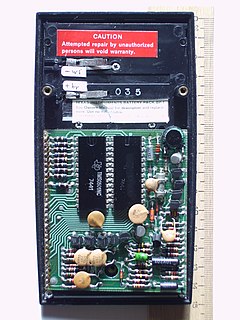
The SR-50 was Texas Instruments' first scientific pocket calculator with trigonometric and logarithm functions. It enhanced their earlier SR-10 and SR-11 calculators, introduced in 1973, which had featured scientific notation, squares, square root, and reciprocals, but had no trig or log functions, and lacked other features. The SR-50 was introduced in 1974 and sold for US$170. It competed with the Hewlett-Packard HP-35.

The HP-25 was a hand-held programmable scientific/engineering calculator made by Hewlett-Packard between 1975 and 1978. The HP-25 was introduced as a cheaper alternative to the ground-breaking HP-65.
Texas Instruments TI-36 is a series of scientific calculators distributed by Texas Instruments. It currently represents the high-end model for the TI-30 product lines.

The TI-Nspire is a graphing calculator made by Texas Instruments which was released in July 2007. The original TI-Nspire was developed out of the TI PLT SHH1 prototype calculator, the TI-92 series of calculators released in 1995, and the TI-89 series of calculators released in 1998.The TI-Nspire features a non-QWERTY keyboard and a different key-by-key layout compared to its predecessors. The TI-Nspire allows users to swap out the existing removable keypad with a functional copy of the TI-84 Plus series keypad. The TI-Nspire series I/O has a connector for the TI-Nspire Lab Cradle, another that serves as a connector for TI's wireless network adapter, and a Mini-USB connector for transferring data. The TI-Nspire series is available with and without a computer algebra system.
The TI-34 name is a branding used by Texas Instruments for its mid-range scientific calculators aimed at the educational market. The first TI-34 model was introduced in 1987 as a midpoint between the TI-30 series and the TI-35/TI-36 series. The TI-34 is better than the TI-34II. Earlier models included Boolean algebra features, though these were removed with the introduction of the TI-34II in 1999, which focuses more on fractional calculations and other subjects common in middle and high school math and science curricula.

The TI-108 is the least expensive, most basic, and most widely used calculator by Texas Instruments. The TI-108 is probably the most common American elementary school calculator due to low price, ruggedness, and solar panel power source. Along with the more expensive and newer TI-10, this calculator targets the K-3 student group for whom it will likely be a first calculator. The TI-15 is targeted to older students.

The Texas Instruments signing key controversy refers to the controversy which resulted from Texas Instruments' (TI) response to a project to factorize the 512-bit RSA cryptographic keys needed to write custom firmware to TI devices.
In computing, Microsoft Binary Format (MBF) was a format for floating-point numbers used in Microsoft's BASIC language products, including MBASIC, GW-BASIC and QuickBASIC prior to version 4.00.

The TMS1000 is a family of microcontrollers introduced by Texas Instruments in 1974. It combined a 4-bit central processor unit, read-only memory (ROM), read/write memory (RAM), and input/output (I/O) lines as a complete "computer on a chip". It was intended for embedded systems in automobiles, appliances, games, and measurement instruments. It was the first high-volume commercial microcontroller. In 1974, chips in this family could be purchased in volume for around $2 each. By 1979 about 26 million parts in this family were sold every year. The TMS 1000 was used in Texas Instruments' own Speak & Spell educational toy, and in the electronic game Simon.



